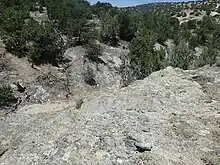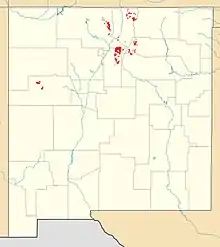Vadito Group
The Vadito Group is a group of geologic formations that crops out in most of the Precambrian-cored uplifts of northern New Mexico. Detrital zircon geochronology and radiometric dating give a consistent age of 1700 Mya for the group, corresponding to the Statherian period.
| Vadito Group Stratigraphic range: Statherian | |
|---|---|
 Vadito Group schists in the Picuris Mountains | |
| Type | Group |
| Sub-units | Big Rock Formation, Burned Mountain Formation, Glenwoody Formation |
| Underlies | Hondo Group |
| Overlies | Moppin Complex |
| Lithology | |
| Primary | Metasedimentary rock |
| Other | Metavolcanic rock |
| Location | |
| Coordinates | 36.193°N 105.797°W |
| Region | Picuris and Tusas Mountains, New Mexico |
| Country | United States |
| Type section | |
| Named for | Vadito, New Mexico |
| Named by | A. Montgomery |
| Year defined | 1953 |
 Map of Vadito Group outcroppings | |
Description
The Vadito Group is an extensive sequence of supracrustal rocks dominated by feldspathic gneisses, feldspathic schists, and metamorphosed sandstones and conglomerates. Its lower section includes amphibolites, though mafic beds make up less than 10% of the unit. It is found in the Picuris Mountains, the Tusas Mountains, the Truchas Range, the Mora River area, the Rincon Mountains (36.0784234°N 105.3502279°W), the northern Taos Range, and in the Cimarron Range.[1][2] Detrital zircon geochronology establishes that the principal source regions for the Vadito Group had ages of 1765 to 1704 Mya.[3] The absolute age of the Burned Mountain Formation constituting the upper part of the Vadito Group in the Tusas Mountains is 1700 Mya, based on uranium-lead dating.[4]
The Vadito Group is divided into the Big Rock Formation and Burned Mountain Formation in the Tusas Mountains, and the upper Vadito Group is assigned to the Glenwoody Formation in the Picuris Mountains. The Burnt Mountain Formation probably correlates with the Glenwoody Formation while the Big Rock Conglomerate corresponds to a disconformity in the Picuris Mountains. Detrital zircon dating indicates that the Marquenas Formation, formerly assigned to the Vadito Group, has a maximum age of 1435 Mya and is not part of the Vadito Group.[3]
The Vadito Group lies structurally above the Hondo Group in the Picuris Mountains. However, both groups have been severely deformed and metamorphosed, and the Vadito Group is thought to actually be the older of the two groups. Cross-bedding indicates that the Vadito Group has been overturned.[2]
Three metamorphic episodes are recognized in the group. Only the third is well constrained in time, occurring around 1420 Mya and reaching the amphibolite facies.[3] This is likely associated with the Picuris orogeny.[5]
The Vadito Group is interpreted to have been deposited in deep water in a volcanic back-arc basin (the Pilar basin) that opened during the Yavapai orogeny.[3]
 Staurolite replacing andalusite in Vadito Group muscovite schist bed
Staurolite replacing andalusite in Vadito Group muscovite schist bed
Economic geology
The Vadito Group is intruded by the pegmatite of the Harding Pegmatite Mine,[6] an historically important source of lithium, beryllium, and tantalum. The Vadito Group has also been mined for kyanite on Mesa La Jara (36.5443°N 106.082°W).[7] Some 1500 tons of kyanite were extracted from Big Rock in 1928, and further prospecting took place in 1948-1949. However, there was no further development of the deposits.[8] The kyanite pods have been interpreted as either metamorphosed pelitic silt lenses,[9] as unusual pegmatites,[10] or as hydrothermal systems.[7][11]
History of investigation
The unit was designated as the Vadito Formation in 1953 by Arthur Montgomery,[12] who had first taken interest in the geology of the Picuris Mountains as a result of his wartime operation of the Harding Pegmatite Mine.[13] P.E. Long recommended raising it to group rank in 1976[14] and this was adopted by Bauer and Williams in their sweeping revision of northern New Mexico Precambrian stratigraphy.[1]
Panorama
Footnotes
- Bauer & Williams 1989, p. 48.
- Bauer 2004.
- Jones et al. 2011.
- Bauer & Williams 1989, p. 49.
- Daniel et al. 2013.
- Montgomery 1953.
- Simmons et al. 2011.
- Correy 1960, p. 58.
- Correy 1960.
- Barker 1958, p. 96.
- Gresens 1972.
- Montgomery 1953, p. 21.
- Montgomery 1953, p. 1.
- Long 1976.
References
- Barker, Fred (1958). "Precambrian and Tertiary geology of Las Tablas quadrangle, New Mexico" (PDF). New Mexico Bureau of Mines and Mineral Resources Bulletin. 45.
- Bauer, Paul W. (2004). "PROTEROZOIC ROCKS OF THE PILAR CLIFFS, PICURIS MOUNTAINS, NEW MEXICO" (PDF). New Mexico Geological Society Field Conference Series. 55: 193–205. Retrieved 15 April 2020.
- Bauer, Paul W.; Williams, Michael L. (August 1989). "Stratigraphic nomenclature ol proterozoic rocks, northern New Mexico-revisions, redefinitions, and formaliza" (PDF). New Mexico Geology. 11 (3). Retrieved 15 April 2020.
- Correy, Allen Frank (1960). "Kyanite Occurrences in the Petaca District, Rio Arriba County, New Mexico" (PDF). State Bureau of Mines and Mineral Resources Bulletins (47). Retrieved 8 May 2020.
- Daniel, C. G.; Pfeifer, L. S.; Jones, J. V.; McFarlane, C. M. (23 July 2013). "Detrital zircon evidence for non-Laurentian provenance, Mesoproterozoic (ca. 1490-1450 Ma) deposition and orogenesis in a reconstructed orogenic belt, northern New Mexico, USA: Defining the Picuris orogeny". Geological Society of America Bulletin. 125 (9–10): 1423–1441. Bibcode:2013GSAB..125.1423D. doi:10.1130/B30804.1.
- Gresens, Randall L. (1972). "Staurolite-quartzite bands in kyanite quartzite at Big Rock, Rio Arriba County, New Mexico ? A discussion". Contributions to Mineralogy and Petrology. 35 (3): 193–199. doi:10.1007/BF00371214.
- Jones, James V., III; Daniel, Christopher G.; Frei, Dirk; Thrane, Kristine (2011). "Revised regional correlations and tectonic implications of Paleoproterozoic and Mesoproterozoic metasedimentary rocks in northern New Mexico, USA: New findings from detrital zircon studies of the Hondo Group, Vadito Group, and Marqueñas Formation". Geosphere. 7 (4): 974–991. doi:10.1130/GES00614.1. Retrieved 15 April 2020.
- Long, P.E. (1976). PRECAMBRIAN GRANITIC ROCKS OF THE DIXON-PENASCO AREA, NORTHERN NEW MEXICO: A STUDY IN CONTRASTS (Ph.D. dissertation). Stanford University. Retrieved 8 May 2020.
- Montgomery, Arthur (1953). "PreCambrian Geology of the Picuris Range, northcentral New Mexico" (PDF). State Bureau of Mines and Mineral Resources Bulletins. 30.
- Simmons, Mary C.; Karlstrom, Karl E.; Williams, Michael W.; Larson, Toti E. (2011). "Quartz-kyanite pods in the Tusas Mountains, northern New Mexico: A sheared and metamorphosed fossil hydrothermal system in the Vadito Group metarhyolite" (PDF). New Mexico Geological Society Field Conference Series. 62: 359–378.
